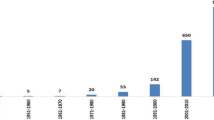Abstract
The aim of this study was to analyse the scientific productivity of the BRIC countries (Brazil, Russia, India and China) in viticulture and oenology through bibliometric analyses of articles in the Science Citation Index Expanded database for the period 1993–2012. A total of 1067 research articles were published in 363 domestic and international journals. We highlight important growth during the mentioned period in the published research papers, particularly in China and Brazil over the last 5 years. Papers have been published in numerous journals in a number of subject areas, such as Revista Brasileira de Fruticultura and Pesquisa Agropecuaria Brasileira, which are the most productive among the BRIC countries. A social network analysis of collaboration between each of the four BRIC countries was also performed.








Similar content being viewed by others
References
Albornoz, M. (2014). Política Científica y Tecnológica: Una visión desde América Latina. Revista Iberoamericana de Ciencia, Tecnología, Sociedad e Innovación. Nº 1. http://www.oei.es/revistactsi/numero1/albornoz.htm. Accessed 28 January, 2014
Aleixandre, J. L., Bordeu, E., Aleixandre-Tudó, J. L., Bolaños, M., & Aleixandre-Benavent, R. (2013). Scientific productivity and collaboration in viticulture and enology in Latin American countries. Ciencia e Investigación Agraria, 40, 429–443.
Aleixandre-Benavent, R., Aleixandre-Tudó, J. L., González Alcaide, G., Ferrer Sapena, A., Aleixandre, J. L., & Du Toit, W. (2012). Bibliometric analysis of publications by South African viticulture and oenology research centres. South African Journal of Science, 108, 74–84.
Aleixandre-Benavent, R., Valderrama Zurian, J. C., & González Alcaide, G. (2007). The impact factor of scientific journals: Limitations and alternative indicators (vol. 16, pp. 4–11).
Babini, D. (2011). Acceso abierto a la producción científica de América Latina y el Caribe. Revista Iberoamericana de Ciencia, Tecnología y Sociedad, 17, 1–24.
Cassi, L., Morrison, A. & Rabellotti, R. (2014). Proximity and scientific collaboration: Evidence from the global wine industry. Papers in Evolutionary Economic Geography, 14(05). Accessed 1 December, 2014. http://econ.geo.uu.nl/peeg/peeg1405.pdf
Cassi, L., Morrison, A., & Ter Wal, A. L. J. (2012). The evolution of trade and scientific collaboration networks in the global wine sector: A longitudinal study using network analysis. Ecomomic Geography, 83, 311–334.
CIA World Factbook. (2011): Statistic. On line, 25th May 2011. https://www.cia.gov/library/publications/the-world-factbook/geos/br.html. Accessed 22 November, 2013
Cunningham, S. J., & Dillon, S. M. (1997). Authorship patterns in information systems. Scientometrics, 39, 19–27.
Cusmano, L., Morrison, A., & Rabellotti, R. (2010). Catching-up trajectories in the wine sector: A comparative study of Chile, Italy and South Africa. World Development, 38, 1588–1602.
Glänzel, W., & Veugelers, R. (2006). Science for wine: A bibliometric assessment for wine and grape research for wine-producing and consuming countries. American Journal of Enology and Viticulture, 57, 23–32.
González-Alcaide, G., Alonso Arroyo, A., González de Dios, J., Pérez Sempere, A., Valderrama-Zurian, J. C., & Aleixandre-Benavent, R. (2008a). Coauthorship networks and institutional collaboration in Revista de Neurología. Revista de Neurologia, 46, 642–651.
González-Alcaide, G., Valderrama-Zurian, J. C., & Aleixandre-Benavent, R. (2008b). Research fronts and collaboration patterns in Reproductive Biology. Coauthorship networks and institutional collaboration. Fertility and Sterility, 90, 941–956.
Guilford, J. M., & Pezzuto, J. M. (2011). Wine and health: A review. American Journal of Enology and Viticulture, 62, 471–486.
Katz, J. S., & Martin, B. R. (1997). What is research collaboration? Research Policy, 26, 1–18.
Kretschmer, H. (1994). Coautorship network of invisible-college and institutionalized communities. Scientometrics, 30, 363–369.
Newman, M. E. J. (2004). Coauthorship networks and patterns of scientific collaboration. Proceeding of the National Academy of Science, USA, 101, 5200–5205.
O’Neill, J., & Stopnytska A. (2011). Linking GDP growth and equity return. Goldman Sachs. Monthly insights from the office of the chairman.
OIV. (2007). International organization of vine and wine. Paris: Statistics.
Pichon-Riviere, A., Ceballos, R. M., & Briones, E. (2009). Health technology assessment in Latin-America and the Caribbean, facilitators and barriers for international collaboration: A survey. Value in Health, 12, 488–2009.
Rojas-Sola, J. I., & Jordá-Albiñana, B. (2009). Análisis bibliométrico de las publicaciones científicas españolas en la categoría materials science, ceramics de la base de datos JCR (SCI) (1997–2008). Boletín de la Sociedad Española de Ceramica y Vidrio, 48, 255–260.
Sánchez Sosa, J. J. (2008). Professional collaboration between psychologists and other health professionals in healthcare settings in Latin America. International Journal of Psychology, 43, 171–179.
Scherngell, T., & Hu, Y. (2011). Collaborative knowledge production in China. Regional evidence from a gravity model approach. Regional Studies, 45(6), 755–772.
Sidone, O., Haddad, E., & Mena-Chalco, J. (2014). Scholarly publication and collaboration in Brazil: The role of geography. ERSA Conference Papers, 14, 187. Accessed 01 December, 2014. http://www.usp.br/nereus/wp-content/uploads/TD_Nereus_01_2014.pdf
Slobodniková, O., & Nagyová, R. (2011). Global influence of the BRIC countries. In The scale of globalization. Think globally, act locally, change individually in the 21st century (pp. 303–311). Ostrava: University of Ostrava.
Vera-Villarroel, P., López-López, W., Lillo, S., & Silva, L. (2011). La producción científica en psicología latinoamericana: Un análisis de la investigación por países. Revista Latinoamericana de Psicología, 43, 95–104.
White, H. D., & McCain, K. (1989). Bibliometrics. Annual Review of Information Science and Technology, 24, 119–186.
World Bank. (2011). Data Word Bank. http://data.worldbank.org/indicator/NY.GDP.MKTP.CD
Author information
Authors and Affiliations
Corresponding author
Rights and permissions
About this article
Cite this article
Aleixandre, J.L., Aleixandre-Tudó, J.L., Bolaños-Pizarro, M. et al. Global trends in scientific production in enology and viticulture in selected emerging economies (BRIC). Scientometrics 103, 649–668 (2015). https://doi.org/10.1007/s11192-015-1543-4
Received:
Published:
Issue Date:
DOI: https://doi.org/10.1007/s11192-015-1543-4




